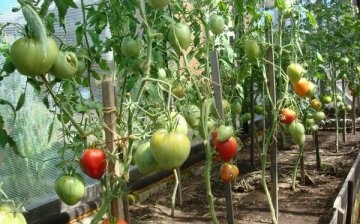Greenhouse tomatoes: planting and care
Growing tomatoes in a greenhouse is not difficult. Anyone, even a novice gardener, will be able to provide their family with fresh and canned food. Of course, in the middle lane and even in Siberia, you can grow tomatoes without a greenhouse, but in this case the yield will be much less, and you cannot count on early vegetables.
Content:
Growing seedlings
Growing greenhouse tomato starts with the selection of varieties. Usually, tall, indeterminate varieties are chosen for greenhouses, which will bear fruit until the very autumn frosts. I will not list their names, since it is best to buy those that are zoned for your region of residence. Varieties that give excellent yields, for example, in the Krasnodar Territory, are unlikely to please the inhabitants of the Urals with them, and vice versa. Usually on the bag with seeds it is written at what time it is recommended to sow them for seedlings. For most varieties, mid to late March is recommended.
Seeds at tomato large, sowing and sprinkling them with a little earth will not be difficult. Many gardeners soak them in water or Epin solution before planting to accelerate germination. When they swell or hatch, they are sown in mini-greenhouses, which are boxes with moist fertile soil, covered with glass or polyethylene. It is very convenient to use plastic transparent disposable containers with a lid. Punch a few holes in the bottom with an awl, and the greenhouse is ready. After germination, the lid is not removed immediately, but when the remnants of the seed peel disappear from the cotyledon leaves.
In the phase of 2-3 true leaves, the plants dive into separate containers, pinching the main root for the accelerated development of a good root system. The main problem when growing seedlings is excessive stretching due to lack of lighting. Therefore, if possible, place it on the western window and supplement it, at least with a table lamp with an energy-saving lamp. If you do not want to mess with seedlings, you can buy ready-made in the greenhouse. There her grow in greenhouses, so the plants are strong, short, with thick trunks. They bloom faster and are distinguished by abundant fruiting.
Landing
Usually recommended plant greenhouse tomatoes, when the threat of recurrent frosts has passed, if the greenhouse is not artificially heated. The beds along the walls of the greenhouse must be prepared well in advance. They are spilled with a solution of potassium permanganate to disinfect the soil, and fertilized with humus or compost, adding it at the rate of 1 bucket per 1 square meter. meter. If you have a good, strong seedling with thick stems, plant it vertically. If it is very elongated, then it is better to plant it horizontally, burying part of the stem. This will provide an additional root system.
Expect the distance between the plants to be at least 40 cm, between the rows - 50 cm. During planting, the soil is shed well, and then left for 10 days without water, so that there is an enhanced formation of roots. During this time, those tomatoes that are planted horizontally will already rise, and they can be tied up.
Care
Agronomists recommend breaking off the stepchildren so as to form the bushes into one stem. This should be done regularly, since stepchildren take away from the plant the forces that should be directed to fruiting.The same can be said for the lower leaves. They are removed as the plant grows. Do not forget that tomatoes love fresh air, which is why it is not recommended to grow them in the same greenhouse with cucumbers, which need heat and high humidity. The greenhouse should have at least two air vents on opposite walls. In especially hot weather the door is also left open. Ideally, the daytime temperature will be 20-24 degrees, and the nighttime - 16-18.
Tomatoes are watered in the greenhouse 2-3 times a week, but abundantly; during the fruiting period, watering should be more frequent. It is convenient to mulch the plantings with dry grass so that the moisture evaporates more slowly. Top dressing of tomatoes in the greenhouse is carried out three times during the growing season. The first one is already three weeks after landing. For her, wood ash and liquid mullein are used. It is important that there is no nitrogen in the fertilizer at this time, otherwise the plants will begin to "fatten" instead of flowering and fruit setting. After another 10 days, a complex mineral fertilizer is applied, for example, "Kemira-universal". After another 1012 days, a third top dressing is applied with a complex fertilizer. If the plants are frail and weak, foliar top dressing with urea will help, when shedding flowers - with boric acid.














Medium and tall varieties of tomatoes are best grown in polycarbonate, glass or plastic greenhouses. With this method of cultivation, they give a higher yield, are less affected by diseases and pests.